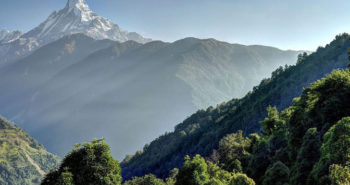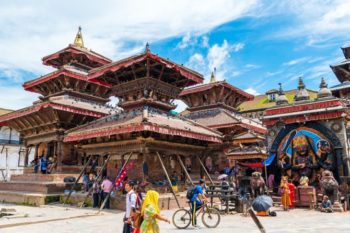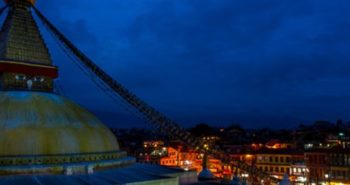Dolpo Trek Altitude Profile
Dolpo sits high in the Dhaulagiri mountain ranges, just south of the Tibetan Plateau. Only opened to trekkers in 1989 Dolpo remains a restricted area. As such it is pristine in terms of flora, fauna, and local culture.
Trekking in Upper Dolpo starts from Nepalgunj. Very different from the high, arid Tibetan influenced area of Dolpo, Nepalgunj sits at just 150m above sea level and is heavily influenced by India, just a few kilometers away. As this trek takes us from 150m to over 5,000m it is important to understand the altitudes you will be encountering. For this reason we have put together this altitude profile which will also tell you how many hours a day you will be walking.
As with any high altitude trek, acclimatization is the key to enjoying your time in safety. Therefore there are some rest days built into the trek.
Quick Facts
- Lowest point: 150m at Nepalganj
- Highest point: Saldang La Pass at 5,100m
- Walking hours per day: 5-6 hours per day on average
- Acclimatization days: 3
Altitude Variations Each Day on the Upper Dolpo Circuit Trek
Day 01 Kathmandu to Nepalgunj (by Flight)
- Elevation at Kathmandu: 1,300m
- Elevation at Nepalgunj: 150m
- Approximate 1 hour 15 minutes flight time
- Elevation loss: 1,150m
Flying from 1,300m at Kathmandu to only 150m at Nepalgunj will not cause any problem. Depending on the time of year you are trekking, the temperature may have more of an affect – Nepalgunj being much hotter than Kathmandu! But in order to avoid spending too much time in the heat we will fly from Kathmandu to Nepalgunj in the afternoon and overnight there before the early morning flight to Jhupal where the trek begins.
Day 02 Nepalgunj to Jhupal Flight and Trek to Dunai
- Elevation at Nepalgunj: 150m
- Elevation at Jhupal Airport: 2,500m
- Elevation at Dunai: 2,850m
- Elevation gain: 2,700m
- Walking time: 3 hours
Flights to Jhupal leave early in the morning from Nepalgunj. Here the crew will be waiting with the camping equipment we will be using over the next 3 weeks. On the first day hike around three hours to Dunai, which is the administrative capital of Dolpo Region. Today the trail takes us through terraced fields until we reach the Bheri River gorge. There is time to explore the small town before retiring for the night.
Note: Between Jhupal and Phoksundo Lake the altitude remains under 3,500m. As it is unusual for anyone to show signs of altitude related illness below 3,500m there is no need to have an acclimatization day within the first 5 days of this trip. Please also note that altitude affects each person differently. It is not related to age or fitness levels so please do tell us if you are feeling unwell even at lower altitudes. See here for more info on altitude sickness.
Day 03 Dunai to Ankhe
- Elevation at Dunai: 2,850m
- Elevation at Ankhe: 2,896m
- Elevation gain: 46m
- Walking time: 5-6 hours
Today the trail takes us upwards through the Thulo Bheri Valley before entering the Phoksundo River Valley. There are a couple of villages on the way and walnut groves to admire. And naturally there are the mountains – Kagmara Peak is on display for us today! Finally the trail goes down through dense jungle like vegetation to Ankhe.
Day 04 Ankhe to Sulighat
- Elevation at Ankhe: 2,896m
- Elevation at Sulighat: 3,180m
- Elevation gain: 285m
- Walking time: 5 to 6 hours
Today’s trail takes us up and down through forests and over a grassy slope above the river. Following the trail downwards, carefully descend a stone staircase to the river bank and on to Sulighat.
Day 05 Sulighat to Phoksundo Lake
- Elevation at Sulighat: 3,180m
- Elevation at Phoksundo Lake: 3,612m
- Elevation gain: 432m
- Walking time: approximately 4 hours
Today we reach the beautiful Phoksundo Lake. But first we follow the valley floor passing Phoksundo and Pungmo rivers and pine forests. From the top of a high ridge we get our first glimpse of the lake. Here we also find one of the highest waterfalls in Nepal. The trail then descends through birch forests to the pretty village of Ringmo on the edge of Phoksundo Lake.
Day 06 Acclimatization Day
Today we take the opportunity to both explore Ringmo village and Phoksundo Lake and also acclimatize to the rising altitude.
Day 07 Phoksundo Lake to Phoksundo Khola
- Elevation at Phoksundo Lake: 3,612m
- Elevation of Phoksundo Khola: 3,507m
- Elevation loss: 105m
- Walking time: approximately 5 hours
Today leave the lake by following the trail to the west, across wooden bridge like structures until we reach a meadow leading to the Phoksundo Khola flood plain. The trail takes us over boggy marsh ground through the valley until the riverbank where we will overnight.
Day 08 Phoksundo Khola to Phoksundo Bhanjyang
- Elevation at Phoksundo Khola: 3,612m
- Elevation at Phoksundo Bhanjyang: 3,910m
- Elevation gain: 298m
- Walking time: approximately 6 hours
Today walk through a glacial valley to the confluence of the Phoksundo Khola and another stream, marked by an old wooden bridge. Climbing north-east we reach a sheep meadow and on to a steep ravine. Climbing up here is hard but we need to reach another valley to where we will eventually cross the Kang La Pass after having a good night’s rest.
Day 09 Phoksundo Bhanjyang to Shey Gompa
- Elevation at Phoksundo Bhanjyang: 3,910m
- Elevation at Shey Gompa: 4,500m
- Elevation of Kang La Pass: 5,300m approximately
- Elevation gain: 590m
- Walking time: approximately 5 hours
We start the day with a very strenuous climb to the top of the Kang La Pass. When at the top there are great views of the valley below. Now the trail descends down to the valley floor by a steep trail. We follow the banks of the river, crossing and recrossing the icy waters. We can see mud caves lining the hills which look down on the river. Before reaching Shey Gompa we walk through meadows filled with yaks, sheep and mountain goats.
Day 10 Acclimatization Day
Today we need to take an acclimatization day as yesterday brought us a 590m elevation gain between Phoksundo Bhanjyang and Shey Gompa.
There are plenty of time to explore the gompa which is of the Bon religion. This is similar to Buddhism but dates from pre-Buddha times. In this area is also the strange Crystal Mountain – with its quartz and marine fossils embedded in its cliffs, which gives it its name.
Day 11 Shey Gompa to Namduna Gaun
- Elevation at Shey Gompa: 4,500m
- Elevation at Namduna Gaun: 4,800m
- Elevation of Saldang La Pass: 5,100m
- Elevation gain: 300m
- Walking time: approximately 6 to 7 hours
Today we walk through juniper trees into a canyon where the trail winds over rocks and loose stones until we reach the top of Saldang La Pass. The descent over the other side is also tiring. Today we can see nomadic herders with their yaks and sheep and tents made from yak hair. Arriving at Namduna Gaun where we will spend the night there is time to explore the red monastery built below a gorge cliff.
Day 12 Namduna Gaun to Saldang
- Elevation at Namduna Gaun: 4,800m
- Elevation at Saldang: 3,620m
- Elevation loss: 1,180m
- Walking distance: approximately 4 to 5 hours
Today the trail takes us through barren mountains to reach Saldang village on a plateau above the Namga Khola. This is the largest village of the inner Dolpo area and is spread over a long (2km) slope. Interestingly it is not just one, but five villages of around 80 houses. Being strategically placed on the trade route to Tibet probably explains why there are so many houses here.
Day 13 Saldang to Yangze Gompa
- Elevation at Saldang: 3,620m
- Elevation at Yangze Gompa: 4,960m
- Elevation gained: 1,340m
- Walking distance: approximately 4 hours
The terrain is barren as we follow the Nagon Khola through the villages of Marang and Ki. Crossing a tributary of the Panzang River a couple of times we reach another Bon monastery of Yangze Gompa.
Day 14 Yangze Gompa to Sibu
- Elevation at Yangze Gompa: 4,960m
- Elevation at Sibu: 4,560m
- Elevation loss: 400m
- Walking distance: 6 to 7 hours
Today we pass terraced fields, mani walls (walls with prayers carved into stones), stupas, chorten and a monastery to Namdo village. This is another prosperous village of around 60 houses and sits high above the Nam Khong Khola. We walk on another 2 hours to camp at Sibu.
Day 15 Sibu to Jeng La Phedi
- Elevation at Sibu: 4,560m
- Elevation at Jeng La Phedi: 4,900m
- Elevation gain: 340m
- Walking distance: approximately 5 hours
Today again we will most likely see caravans of yaks as we walk east and then ascend to a grazing pasture below the Jeng La Pass.
Day 16 Jeng La Phedi to Tokyo Gaun
- Elevation of Jeng La Phedi: 4,900m
- Elevation of Tokyu Gaun: 4,209m
- Elevation of the Jeng La Pass: 5,100m
- Elevation loss: 691m
- Walking distance: 5 to 6 hours
Since we are starting from Jeng La Phedi at 4,900m we are actually only ascending 200m to cross the pass. From the pass we see the amazing sight of the north face of the Dhaulagiri Massif. Crossing the pass, the trail descents along rough ground to the Tarap Valley and the monastery at Tokyu.
Day 17 Tokyo Gaun to Dho Tarap
- Elevation at Tokyo Gaun: 4,209m
- Elevation at Dho Tarap: 4,040m
- Elevation loss: 189m
- Walking distance: 4 hours
Today we enter different countryside: marshes and grasses line the river banks.
Day 18 Rest Day
On this rest day we spend the day in Dho Tarap. Here there are around 40 houses of mainly people known as Magars, a hill tribe of Nepal. There are also some Tibetans living here and Buddhism is still a big feature of the area. In fact there is a Bon Gompa a short distance from the village. Today explore the village, gompa and surrounding area.
Day 19 Dho Tarap to Tarap Khola
- Elevation at Dho Tarap: 4,040m
- Elevation at Tarap Khola: 3,800m
- Elevation loss: 240m
- Walking distance: approximately 6 hours
The trail takes us through juniper and wild roses towards a wide valley, narrowing to a gorge. Again we see herds of sheep before reaching the confluence of the Tarap Chu and Lang Khola rivers. We camp near the Tarap River.
Day 20 Tarap Khola to Khani Gaun
- Elevation at Tarap Khola: 3,800m
- Elevation at Khani Gaun: 3,150m
- Elevation loss: 650
- Walking distance: approximate 4 hours
Today we meet many local people on the way, mainly taking their herds to lower pastures. We walk over stone slabs, logs, and rough bridges and perhaps even through the river itself!
Day 21 Khani Gaun to Tarakot
- Elevation at Khani Gaun: 3,150m
- Elevation at Tarakot: 2,537m
- Elevation loss: 613m
- Walking distance: 4 hours
Today follow the path to Lalberi village and on through forests and a gorge until we are following the river again. There is another monastery we can visit today on a hill above the Bheri River. Tonight we camp at Tarakot. Today is a short walking day as there is no suitable camping place between here (Tarakot) and Dunai which we will reach tomorrow.
Day 22 Tarakot to Dunai
- Elevation at Tarakot: 2,537m
- Elevation at Dunai: 2,850m
- Elevation gain: 313m
- Walking distance: 5 to 6 hrs
Today’s hiking is relatively easy, through a pine lined gorge and along the Bheri River to reach Dunai.
Day 23 Dunai to Jhupal
- Elevation at Dunai: 2,850m
- Elevation at Jhupal: 2,500m
- Elevation loss: 350m
- Walking distance: 2 to 3 hours
Today is the final day of the trek, with a short easy walk to Jhupal.
Day 24 Jhupal to Nepalgunj and Kathmandu
- Elevation at Jhupal: 2,500m
- Elevation at Nepalgunj: 150m
- Elevation at Kathmandu: 1,300m
- Elevation loss: 1,200m
- Total time: approximately 4 to 5 hr
This morning take an early morning flight from Jhupal to Nepalgunj then connect by another flight to Kathmandu.
Altitude Sickness
The Upper Dolpo Trek is a high altitude trek with more than half the trekking days being above the height that is suggested as being the possible starting point of altitude related problems. That is to say, over 3,500m some people may experience altitude sickness.
The key to avoiding altitude sickness is to go slow, stay well hydrated and take acclimatization days.
We cannot tell who is more likely to suffer from altitude related problems. It is not related to overall fitness or age. It happens when your body finds it hard to adjust to the changing oxygen and pressure levels experienced in high places.
We would like to make you aware of the symptoms so you can recognize them not only in yourself but in fellow trekkers.
What is Altitude Sickness?
This is a general term given to symptoms that can happen when you ascent too quickly. Yes, they can turn life-threatening so the trick is to recognize the symptoms early on. Here is what you should look out for:-
- Feelings of uneasiness
- Breathing difficulties
- Intense headaches
- Increased heart rates
- Nausea and vomiting
- Light headedness
- Difficulty in sleeping
If you have any of these symptoms you should tell the guide or group leader immediately. If you have any of these symptoms you should not try to ‘be brave’ and keep on going. Ascending higher will only increase the symptoms and put you at risk. You need to rest. Most people will feel better after a rest day, others will require medicines. But if that does not work, you will need to descend. If symptoms still do not go it might be you need to abandon your trek.
How to Avoid Getting Altitude Sickness
To lower the risk of altitude sickness you can do the following:
- Most importantly – stay hydrated. You should drink at least 2-3 liters of water per day. More if you can.
- Walk at your own pace. Give your body time to adjust to the changing altitude.
- Eat carbohydrates – you need more calories at high altitude! Bet you have never been told to eat more carbs before!
- Avoid alcohol and cigarettes on your trek if you can. Alcohol may dehydrate your body while cigarettes may cause difficulty in breathing, increasing the chances of getting altitude sickness. Save that beer for special days or the end of the trek!
FAQs
Can I get altitude sickness on the Upper Dolpo Trek?
Although we do not know who will have altitude related problems, the general answer is yes. Yes because this is a very high altitude trek. But with the proper precautions you can reduce the likelihood of getting altitude sickness.
What can I do if I get altitude sickness on my trek?
If you get altitude sickness on your trek, please inform your guide and group members immediately. Your guide will provide you with the immediate first aid. Rest, do not try to ascend further. If the symptoms do not go away after proper rest and medication, you should go down to a lower altitude.
How to know if I have got altitude sickness?
If you feel the following symptoms (some, not necessarily all) and they persist for some time it is likely you have altitude sickness. Let your guide know immediately. Some of the symptoms might be for other reasons (ie stomach problems, unable to sleep due to an unfamiliar place or excitement) but by letting your guide know he can assess the situation properly.
Feelings of uneasiness
Breathing difficulties
Intense headaches
Increased heart rates
Nausea and vomiting
Light headedness
Difficulty in sleeping


